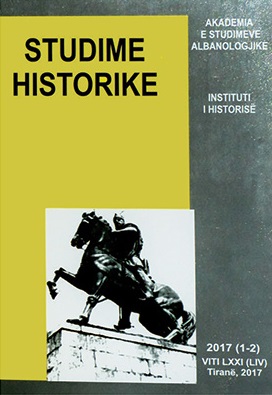Dy plane konkurruese austro-hungareze të vitit 1918 – dërgimi i monumenteve antike drejt Sarajevës apo ndërtimi i një muzeu kombëtar shqiptar?
The two Austro-Hungarian competing plans of 1918 – the delivery of ancient monuments to Sarajevo or the construction of a national Albanian museum?
Author(s): Kurt GostentschniggSubject(s): Cultural history, Museology & Heritage Studies, Governance, Political history, Pre-WW I & WW I (1900 -1919), Politics of History/Memory
Published by: Qendra e Studimeve Albanologjike
Keywords: Political history; Austro-Hungarian empire; antique monuments; Sarajevo; Albanian national museum; moving monuments to Sarajevo;
Summary/Abstract: A very good example of the interactive cooperation between the actors of politics, army and science is the matter of rescuing antique monuments in the Albanian territories under austro-hungarian military administration during 1916 – 1918. The main collective actors were the Ministry of Foreign Affairs, The Common Ministry of Finance and the Ministry of War in Vienna, the Institute for Balkan Studies and the National Museum in Sarajevo, the Corps Command in Scutari and the Headquarters in Teschen in Austrian Silesia. The main individual actors on the field in Albania were the civil commissary August Kral as representative of the field of politics, Carl Patsch, director of the Institute for the Balkan Studies in Sarajevo as representative of the scientific or Albanian Studies’ field as well as the officers and Albanian Studies’ scholars Georg Veith and Camillo Praschniker being in a double position as representatives of the military and Albanian Studies field. To the solution of the abovementioned matter came two options into question: either were the monuments to be sent to Austria-Hungary, or to be collected in some safe place in Albania. The young archaeologist Praschniker gave the piece of advice to move the monuments to safe Austrian ground or at least to some safe Albanian ground like Scutari or Durrës. The original plan of Patsch who was working on behalf of Vienna was to send the monuments to the National Museum of Sarajevo. It was Kral’s idea that the monuments remain in Albania and an Albanian National Museum be built for their sheltering. Kral urged the Corps Command to take measurements in favor of securing the antique monuments. Since the end of February 1918 it was made possible to send a collection of antique statues and inscriptures to Durrës to create the basis of an Albanian museum of Antiquity. Because of his pesimistic appraisal on future Albania Veith intervened for a provisional transfer of the monuments to the National Museum of Sarajevo or at least to their provisional storage in Durrës for study purposes of the Institute for Balkan Studies. By beginning of June 1918, regarding the transport of the monuments collected by him in Albania to the National Museum of Bosnia, Praschniker, taking into consideration the changed situation of war in the country, changed track of his first idea to build an Albanian national museum in favor of sending the antique objects to Sarajevo. Under this situation the failure of Austria-Hungary in the World War I dictated in the meantime the failure of both competing plans on the destiny of the Albanian antique monuments. By the end of World War I the original idea of Kral was taken again into consideration by the Albanian government which charged Patsch in 1922 with the arrangements of establishing an Albanian National Museum. Unfortunately, because of political unrest within the country, his work remained just on the plan stage.
Journal: Studime Historike
- Issue Year: 2017
- Issue No: 01-02
- Page Range: 147-163
- Page Count: 17
- Language: Albanian
- Content File-PDF

